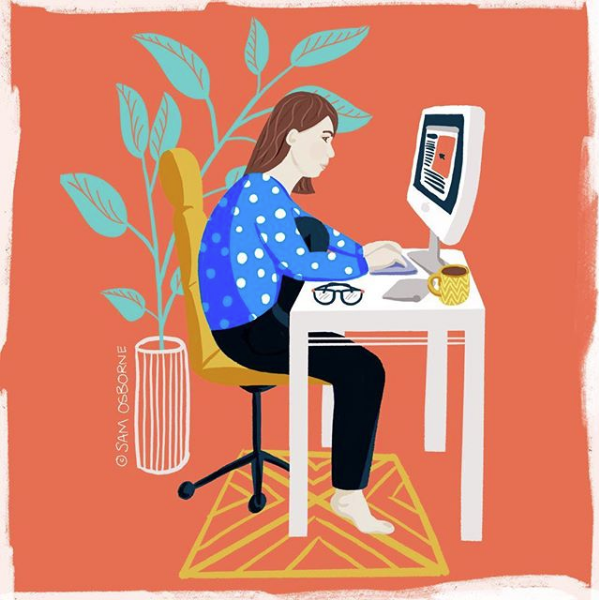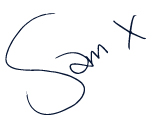I often get emails from students and people just starting out in their creative careers asking about life as an illustrator, how I got started and what it’s like to work as a designer and illustrator so I thought I’d collect up some of those questions and answers here.
 I would like to know how you got started in your field. How did you get into the position you are now and what steps did you take?
I would like to know how you got started in your field. How did you get into the position you are now and what steps did you take?
I studied graphic design at university and worked as a print and branding designer for over 10 years after I graduated. I worked for small agencies were I got to see the whole range of skills and jobs required to run a creative studio – from the creative bits themselves to quoting, working with suppliers and dealing directly with clients. In 2010 I started looking around for my next step. I interviewed at various agencies but couldn’t find anything that got me excited. At the time I really missed drawing – my job role was very straight graphic design and typography so not much room for drawing or illustration. At some point in the job hunting process someone suggested going freelance and a little light bulb went off in my head. I figured it was a pretty good way to allow me to get back to creativity on my terms and the adventure of it seemed exciting.
At that time I knew NOTHING about the world of illustration and surface design (honestly, I didn’t even know surface design was a thing!) so I took some freelance design and art director roles for a year while I taught myself everything I could about the industry and worked out how to draw again!
I have had a look at your website and it seems you work in a freelance capacity. Do you think freelancing is a suitable career beginner for a graduate or would you suggest working for a design company? Is it easy to balance deadlines as a freelancer?
I think it really depends on you, how confident your are and how you feel about making mistakes. For me the experience of working in various design businesses was invaluable and stopped me making rookie errors when I started my business. Small agencies are great as you see everything that goes on in a creative business and you have to be hands on with so much more. You can obviously teach yourself how to work to deadlines, deal with clients, where to find good suppliers and how to charge for jobs but having a few years under someone else’s wing will mean you cut out a lot of mistakes if and when you start up for yourself.
Balancing deadlines is just one of the tough things about being a freelancer, but that usually comes down being able to accurately estimate how long a project will take, not taking on too much work at any one time and charging properly for your work so you don’t feel you have to work every hour under the sun just to be able to afford to eat. But the trickiest thing with freelance life as an illustrator is that you have to be the creative, the marketing manager, the sales team, the financial officer, the procurement department, the press officer, the copywriter, the secretary, the web builder, the SEO expert and more (including the tea lady and the cleaner!) and it’s probably pretty unlikely that straight after your degree you have experience of all of that. I know I didn’t.
Are there many internships available for graduates or is it that your style of work that gets you noticed?
I have no idea really about internships – my view is that more of the creative industries should work on an apprentice basis so I hope there are good vocational opportunities for graduates, but I suspect the real opportunities come from the internet. Promoting yourself and your work, seeking out appealing competitions or challenges to be part of, going to shows, joining groups and associations, filling up your Instagram with amazing work, starting an Etsy shop are ways to get yourself noticed by the people you’d like to impress. So I guess yes, it is your style of work that gets you noticed but only if you work hard to make sure people are able to notice it!
If you were in a meeting with a new illustrator, what type of advice would you give them?
Try everything, don’t pigeonhole yourself into being one type of creative – ‘editorial illustrator’, ‘brand designer’, ‘surface pattern designer’ etc. There are soooooooo many opportunities out there and I would tell new illustrators to try them all. Sell work on print on demand sites, make your own range of t-shirts, start a magazine, start a blog, offer your services to local businesses, start an email list of people you want to work with and email them samples of your work. It’s hard to get traction and it requires constant effort over a huge range of channels. Plus some of these things could start to bring you an income without having to land a big client.
The year I quit my job I sat a wrote a huge list of anything and everything I could do as part of my job – from branding for local small business to designing fabric to writing a cookery book and I tried as many of them as possible, gradually dropping those that didn’t work or I hated. Now I have a range of ways I earn money, all of which are things I enjoy, and that is the best thing about my job!
As technology is ever expanding, do you think there is still room for hand-drawn illustrations or is illustration all about digital designs?
I think that hand-drawn is absolutely as valid as digital designs. In a lot of ways as our world gets more digital the appeal of a hand-drawn style is even greater. But I don’t think you have to see it as one thing or another. I work in both styles but nearly all my work is technically digital as even my hand drawn work is created on my iPad. Lots of illustrators combine hand-drawn or painted elements with digital design, and repeat patterns are almost always created with some digital help. The appeal of work comes from what it has to say not how it was created. It’s easy to get caught up in this digital vs hand-drawn argument as an illustrator but I don’t think clients and customers think about it in the same way. The market for illustration has grown a lot of over the last few years and that means there is room for all kinds of styles, approaches and mediums.
If you’ve got any questions for me drop me a line or check out my About page to find out more about me

